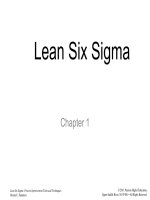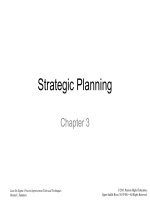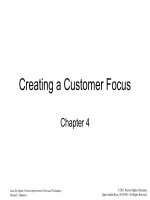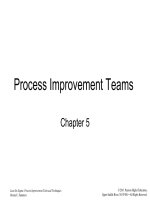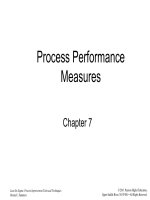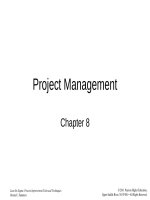LEAN SIX SIGMA OVER VIEW
Bạn đang xem bản rút gọn của tài liệu. Xem và tải ngay bản đầy đủ của tài liệu tại đây (1.27 MB, 38 trang )
LEAN SIX SIGMA OVER VIEW
KIEU VAN TON
Page 1 of 38
Classroom Logistics
•
•
•
•
•
•
You will get acquainted with fellow class participants
You will get to know who the Instructors are
We will make sure that you have all the proper training materials and software
You will understand what is an adult learning environment
We will establish a baseline of statistical knowledge
You will begin to develop an understanding of the Lean Six Sigma Improvement
Processes
• We will present an overview of the Lean Six Sigma material to be covered this
course
• You will understand the benefits of becoming a Green Belt
Page 2 of 38
Classroom Logistics
• Name
• Business Group/plant/location
• Years experience
• Hobby/interest
• Project problem statement
• Expectations (let’s capture these on flipcharts)
• Please limit your introduction to less than 60 seconds
Page 3 of 38
Classroom Logistics
• Expectations are that you:
• Have a project and Project Charter
• Will actively participate in class
• Will follow the Code of Conduct
• Will come to class prepared
Page 4 of 38
What is six sigma?
• A statistical measure for determining process capability (Six Sigma
Quality level equates to 3.4 defects per million opportunities)
• A proven set of tools and tactics for reducing variation
• A successful business strategy (in use by GE, Motorola, Texas
Instruments, Eli Lilly, Roche, Bank of America….)
• A comprehensive philosophy about operational excellence
• A complementary discipline to existing tools
• Focus on Customer Satisfaction, Improving Process Capabilities, and
Organization-wide Involvement
Page 5 of 38
COST OF QUALITY
Cost
Impact of Quality Level on Cost
Optimum
Sigma Quality Level
Page 6 of 38
Why We Need Six Sigma
Defects per Million
1,000,000
Cost of Poor Quality is
25% to 40% of Sales
Revenue
100,000
10,000
Average
Company
1,000
100
10
Best-in-Class
1
2
3
4
5
6
Sigma Quality Level Scale of Measure
The Basic Objective
7
Page 7 of 38
7
What is six sigma?
Six Sigma
Sigma Value
Faults (or event)
Per million opportunity
Yield
%
1
691462 30.85
2
308538 69.146
3
66807 93.319
4
6210 99.379
5
233 99.9769
6
3.4 99.99966
Page 8 of 38
INPUTS
( Sources of Variability)
People
Material
PROCESS
ACTIVITY
PROCESS
ACTIVITY
OUTPUTS
( Measures of Performance)
Perform a service
Equipment
Perform a product
Policies
Procedures
Methods
A Blending of
Inputs to
Achieve the
Desired Outputs
Environment
Page 9 of 38
Complete a task
Scrap = 1
i/p = 100
Scrap = 2
Scrap = 3
99
Extrude
97
Press
Scrap = 1
94
Trim
o/p = 93
Inspect
Rework = 8
Rework = 11
2
3
Stage
1
Logistic
Yield
99/100 = 99%
97/99 – 98%
94/97= 97%
93/94 = 99%
First
Time
Yield
99/100 = 99%
89/99 = 90%
83/97 = 88%
93/94 = 99%
Page 10 of 38
4
THE IMPROVEMENT PROCESS
Logistic yields compared with first-time quality
capabilities of a multi-stage stage.
Logistic Yield = ( good output/input) x 100
First Yield = [(N – W) / N] x 100
• Overrall logistic yiled = apparent yield = 93/100
= 93% ( nearly 3 Sigma process)
• Overall first time yield = real yield = (100 -1 -10 -14 – 1) / 100
= 74% (just over 2 Sigma process)
Page 11 of 38
Defect opportunities
Below is an example of counting the number of
defect opportunities in the production of wooden
chairs:
Company A is producing 5 orders for customer, each
order has one wooden chair item (5 units).
Opportunity per wooden chair item is clarified as
follows:
Page 12 of 38
Defect opportunities
• The chair was made by correct material?
(1 opportunity)
• Moisture content of wood is within the standard (1
opportunity)
• The chair was made in correct size?
(1 opportunity)
• The chair has no damage? (1 opportunity)
• Correct finishing is applied (1 opportunity)
• Correct packaging method is applied
(1 opportunity)
Page 13 of 38
Defect opportunities
Total number of defect opportunities
= Units x Opportunities
= 5 x 6 = 30 opportunities
Page 14 of 38
Problem solving & Process Improvement
Problem solving
Process Improvement
Identify the problem
Identify the process
Clarify the problem and
approach
Define flow of activities
Measure of the extend of
problem
Establish ownership measure
Analyze and determine causes
Probe the process
Develop Preventive action
plan
Develop process improvement
Implement to prevent
recurrence
Implement improvemennt
Page 15 of 38
Process Sigma
Value
Expectation of
Time without electricity
Per month
Aircraft landing/takeoff incidents in
each direct return flight
2
207 h
8 per 10 flights
3
45 h
24 per 100 flights
4
4h
25 per 1000 flights
5
9 min
9 per 10000 flights
6
8 sec
12 per million flights
Page 16 of 38
Why Six Sigma? – Dr. Deming on Process
“Eighty-five percent of the reasons
for failure to meet customer
expectations are related to
deficiencies in systems and
process… rather than the employee.
The role of management is to
change the process rather than
badgering individuals to do better.”
17
Page 17 of 38
DMAIC
D – DEFINE – XÁC ĐỊNH
M – MEASURE – ĐO LƯỜNG
A – ANALYZE – PHÂN TÍCH
I – IMPROVE – CẢI TIẾN
C- CONTROL – KIỂM TRA
Page 18 of 38
DEFINE
Define
• Key questions:
- what matters to customers?
- what defect are we trying to reduce?
- by how much?
- by when?
- what is the current cost of defects?
- who will be in the project team?
- who will support us to implement this project?
• TOOLS:
•
•
•
•
•
PROJECT CHARTER
PARETO CHART
QFD
KANO ANALYSIS
PROCESS FLOW DIAGRAM
Page 19 of 38
Measure
MEASURE
• Key question
-
What is the process? How does it function?
Which Output affect CTQ’ s most?
Which Input affect Output CTQ’ s most?
Is our ability to measure/detect sufficient?
How is our current process performing?
What is the best that the process was designed
to do?
• TOOLS:
•
•
•
•
•
•
FISH BONE
HISTOGRAM
NORMAL DISTRIBUTION
PROCESS FLOW DIAGRAM
CONTROL CHART
MSA
Page 20 of 38
Analyze
ANALYZE
• Key question
Which Input actually affect our CTQ’ s most?
By how much?
Do combination of variables affect outputs?
If an Input is changed does the output really change in
the desired way?
- How many observations are required to draw
conclusion?
- What is the level of confidence?
-
Page 21 of 38
Analyze
ANALYZE
• TOOLS:
- FIVE WHY
- TEST FOR NORMALITY (DESCRIPTIVE
STATISTICS, HISTOGRAMS)
- ANALYSIS OF VARIANCES (ANOVA) FMEA
(FAILURE MODE & EFFECT ANALYSIS)
HYPOTHESIS TESTING METHODS –
Page 22 of 38
Improve
IMPROVE
• Key question
- Once we know for sure which Inputs most effect our
Outputs, How do we control them?
- How many trials do we need to run to find and confirm
the optimal setting/procedure of these key Input?
- Who should the old process be improved and What is
the new process?
- How much have Defect Per Million Opportunities
(DPMO) decreased?
Page 23 of 38
Control
CONTROL
• Key question
- Once defects have been reduced, how do we ensure
that the improvement is sustained?
- What system need to be in place to check that the
improved procedures stay implemented?
- What do we set up to keep it going even when things
changes?
- How can improvements be shared with other relevant
people in the company?
Page 24 of 38
Control
CONTROL
• TOOLS:
•
•
•
•
PROCESS FLOW DIAGRAM
CONTROL CHART
CONTROL PLAN
CHECK SHEET
78.35
78.3
78.25
78.2
78.15
78.1
78.05
78
77.95
77.9
77.85
77.8
Series4
Series5
Series6
Series7
Series8
Series9
1 2 3 4 5 6 7 8 9 10 11 12 13 14 15 16 17 18 19 20 21 22 23 24 25
Page 25 of 38


